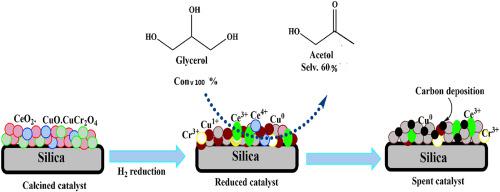Journal of Rare Earths ( IF 5.2 ) Pub Date : 2021-01-26 , DOI: 10.1016/j.jre.2021.01.013 S. Basu , Vibha Shree , A.K. Sen

|
Cerium-promoted silica supported copper chromite catalyst was synthesized from acid hydrolysis of sodium silicate by sol–gel method. The catalyst was characterized by Brunauer–Emmett–Teller (BET) method, field-emission scanning electron microscopy (FESEM), X-ray diffraction (XRD), H2-temperature programmed reduction (H2-TPR), NH3-temperature programmed desorption (NH3-TPD) and pyridine adsorbed Fourier transform infrared spectroscopy (Py-FTIR). Among cerium doped catalysts, 5 wt% of Ce promoted copper chromite supported by 40 wt% of silica (SiCuCr40–Ce5) shows the largest BET surface area. XRD analysis of the reduced form of the catalyst shows both CeO2/Ce2O3 redox system and CuO/Cu2O/Cu redox system. Py-FTIR shows the maximum number of Lewis acid sites for SiCuCr40–Ce5 than others. The highest acetol selectivity with analytical reagent (AR) grade glycerol conversion is observed for SiCuCr40–Ce5 at 200 °C for 3 h in a batch reactor at atmospheric pressure. Cerium promotion lowers the reaction temperature with enhanced glycerol conversion and increased acetol selectivity. Though the above catalyst shows higher conversion for laboratory reagent (LR) grade glycerol but it reduces acetol selectivity. The addition of glucose into the LR grade glycerol further reduces glycerol conversion and decreases the acetol selectivity to zero. This may be due to the presence of iron as impurity in LR grade glycerol. XRD analysis of spent catalyst shows the absence of redox catalytic system and the pore volume reduces identified by BET analysis. Raman analysis of the spent catalyst shows graphite-like carbon deposition in the spent catalyst.
中文翻译:

铈作为促进剂的作用及在亚铬酸铜催化剂上甘油脱水制丙酮的工艺优化研究
以硅酸钠酸水解溶胶-凝胶法合成了铈促进的二氧化硅负载亚铬酸铜催化剂。该催化剂通过Brunauer-Emmett-Teller(BET)法、场发射扫描电子显微镜(FESEM)、X射线衍射(XRD)、H 2 -程序升温还原(H 2 -TPR )、NH 3 -温度表征程序解吸 (NH 3 -TPD) 和吡啶吸附傅里叶变换红外光谱 (Py-FTIR)。在铈掺杂的催化剂中,由 40 wt% 的二氧化硅 (SiCuCr40–Ce5) 负载的 5 wt% 的 Ce 促进亚铬酸铜显示出最大的 BET 表面积。催化剂还原形式的XRD分析表明CeO 2 /Ce 2 O 3氧化还原系统和CuO/Cu 2O/Cu 氧化还原系统。Py-FTIR 显示 SiCuCr40–Ce5 的路易斯酸位点数量最多。在大气压下的间歇式反应器中,在 200 °C 下 3 小时,观察到 SiCuCr40–Ce5 的最高丙酮醇选择性和分析试剂 (AR) 级甘油转化率。铈促进剂通过提高甘油转化率和增加丙酮醇选择性来降低反应温度。虽然上述催化剂对实验室试剂 (LR) 级甘油显示出更高的转化率,但它降低了丙酮醇的选择性。将葡萄糖添加到 LR 级甘油中进一步降低了甘油转化率并将丙酮醇选择性降低到零。这可能是由于 LR 级甘油中存在杂质铁。用过的催化剂的 XRD 分析表明不存在氧化还原催化体系,并且通过 BET 分析发现孔体积减少。废催化剂的拉曼分析显示废催化剂中的石墨样碳沉积。











































 京公网安备 11010802027423号
京公网安备 11010802027423号